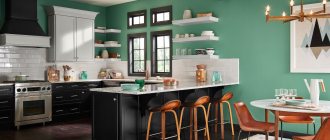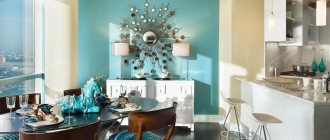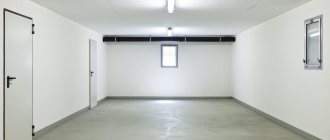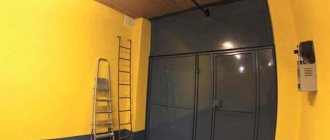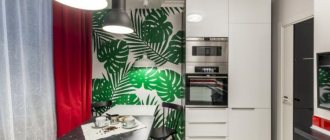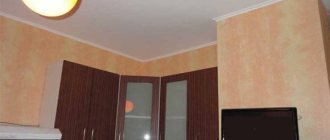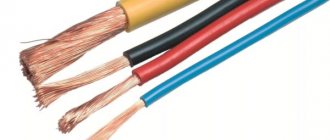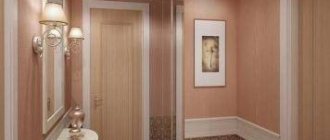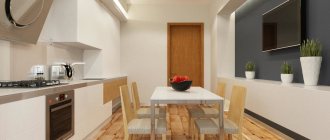What is color for us, what effect does it have on us? This is a very important factor in our lives; it affects our health, state of mind, and relationships.
The color of the walls in the kitchen is a very important design element, on which the harmony of the entire interior will depend.
When we are at home, we spend most of our time in the kitchen. That is why it is necessary to approach the choice of colors not only for the set, other furniture, but above all for the walls of this room with all seriousness. What color is best to paint the kitchen, let's look below at what experts advise.
A competent choice of shade will allow you to set a certain mood for the room and create a favorable atmosphere in it.
Color for kitchen walls: selection rules and recommendations
Let's look at the key principles of kitchen design.
To decorate a small kitchen, you should choose pastel shades.
- A large image visually reduces the size of the room.
- Small things, on the contrary, visually make the room larger.
- Intersecting stripes imitating tartan create the illusion of constant space.
- Vertical increases the height of the ceiling, the room appears higher.
- Drawings and stripes in a horizontal image make the kitchen wider, but its height is reduced.
- Diagonally located stripes make the room more dynamic.
- Textured wallpapers look very unusual. By giving the surface of the walls new qualities, they form an auxiliary dimension. Unexpected effects are obtained from the play of shadows, color aspects, and alternation of textures.
Dark colors visually conceal and reduce the area of the room, while light colors significantly increase it.
The background for the design is created by the walls. When choosing a color scheme, be sure to take into account the height of the ceiling, the size of the kitchen, style, lighting design, and furniture. Light shades are preferable in small kitchens; they make the room appear larger.
Feng Shui recommends choosing cool or light shades, such as white, green, light yellow, beige, light brown or blue.
On a note. You should not paint the walls in rich and provocative colors, especially if the kitchen is small and you are there most of the time.
Shades of the dark color spectrum should be used for kitchens located on the sunny side.
For large kitchens, dark shades are appropriate; in this case, the room looks smaller. Cold tones are not recommended here; the kitchen will look boring and faceless. If there is little sun, there is a lack of lighting, warm colors are suitable: beige, orange, yellow. If you have a sunny side, avoid deep bright tones; in the sun they will become even more saturated.
It is not advisable to use cool colors in a kitchen that is too spacious.
Nowadays green, for example, pistachio or light green, is widely used - experts are sure that it improves digestion. Soft tones are also in fashion, white is trendy - it is suitable for any style.
In a room with walls in subtle colors, you should create one accent wall.
Algorithm for applying CM
The order of application of different types of CM is dictated by the type of binder, base, and depends on the effect expected after painting. But for everyone there is a general algorithm for covering the base:
- All decorative elements (plinths, door frames) are removed from the room.
- Interior items that remain in the room are covered with film. The floor, windows, and apron are also protected from accidental drops of paint.
- The work uses a painting tool: a brush or roller. A nylon or polyester brush is needed for applying water-based and water-dispersed dyes. A brush with natural bristles is used when working with alkyd. There are no traces left of her. A roller with a velor roller is purchased to cover smooth surfaces; the pile is chosen to be short. With a medium one it is convenient to paint a textured wall, with a long one – a rough base. It is not recommended to use a sponge roller in the kitchen. For corners, jambs, space near the frame, around the battery, use a 50 mm wide brush.
- The decorative coating is carried out in two or three layers. The drying time for each layer is indicated by the manufacturer on the container. After one layer has dried, the next one is applied.
- Since the covering layer of the alkyd composition is dense, it is applied with some peculiarities. The first layer is “retouching”, it is better to work with a brush. The second layer is created evenly with a roller.
Advice: readiness for use occurs differently for each species. The time for complete polymerization is indicated in the instructions for the CM and can occur after 30 days. Therefore, there is no need to test the coating immediately after painting.
Basic rules for combining colors in the interior
You will get an excellent design if you correctly combine all its components: the color of the walls, furnishings, design of the ceiling and floor. For example, a white set combines perfectly with red, dark red, green, peach, yellow, and blue wall backgrounds.
Classic wood furniture looks ideal in yellow-red, beige or milky shades.
Principles of color combinations.
- Milky - harmonizes perfectly with all colors, most well with blue, burgundy and dark.
- Light brown - goes well with azure, brown and milky.
- Grayish is a dull tone, but is considered basic. Perfect with rich pink, reddish, lilac, rich blue.
- Pink – chestnut, milky, yellow-green, grayish, blue are suitable for this color.
- Burgundy - perfectly harmonizes with yellowish, snow-white, emerald, blue, black, gray.
- Brown - with light azure, beige, red, emerald, beige.
- Orange - with azure, blue, lilac, light purple.
- Yellow - with blue, lilac, azure, black, grayish.
- Pistachio – with amber-brown, yellow, dark, cream.
- Azure - with scarlet, gray, orange, milky, yellow.
- Blue - with lilac, emerald, yellow, orange, red.
- Black is a multifunctional, elegant tone. Looks good with absolutely all colors.
The most optimal combination is with orange, emerald, milky, yellow and red.
It may seem that choosing a perfect color palette is not easy. Of course, this will take time to achieve the desired effect. But by using the principles described above in practice, you can achieve the desired result.
If the set is made in bright, eye-catching colors, then it would be advisable to paint the walls in calmer and neutral colors or vice versa.
Plastic panels
Another durable way to create the most unusual kitchen design is to use plastic panels. They can imitate marble, wood, frescoes, fabric or be extremely artificial, which is especially suitable for modern designs.
The advantages of this design are:
- Easy to clean;
- Calm attitude towards moisture, temperature, dirt, aromas;
- Easy installation;
- Low cost.
However, the coverage:
- It is not a very environmentally friendly material;
- It will take up space to create the sheathing;
- Accumulates moisture under the surface and therefore requires regular ventilation.
This type of finishing is especially in demand in spacious rooms designed in minimalist or high-tech style. In this case, choose plain glossy panels that expand the walls of the room and add light.
What color is best for the kitchen space?
In order not to make a mistake in choosing a color, many factors are taken into account. First of all, what the hostess herself wants. She needs to be comfortable, since she has to spend quite a lot of time here. If she likes everything, then the dishes will be great. It is worth considering the opinions of other family members, because everyone loves to gather in the kitchen.
You can always find the optimal solution.
Do you have small children in your family and are there problems feeding them? The right color scheme will help solve this problem. A psychologist's advice wouldn't hurt either, since some shades affect the subconscious, emotionality, and appetite.
The photo shows a white kitchen set in combination with a sky-colored wall.
In small rooms it is better to use light colors, this will expand the area. It will be more comfortable with dark facades. It is also important how the windows are located. To the north, facades need warm colors, to the south - cool tones.
The color palette of the walls is considered the most important element in decorating a kitchen.
Preparing the base
Some acrylic, acrylate and latex paints have good hiding power, which can make minor defects invisible. But, basically, good preparation is required - the walls are first plastered, then puttied and sanded until a perfectly flat plane is obtained. To obtain a reliable base, fiberglass fabric is glued onto the layer of starting putty. It serves to reinforce the base. After the glue on the “web” has dried, the walls are leveled with finishing putty and finally sanded.
Painting kitchen walls with glossy or semi-gloss paints requires very smooth walls: the gloss reveals even the slightest irregularities. To get a good result, pay maximum attention to this issue. You can highlight all the irregularities using an LED lamp. It very clearly indicates all the irregularities.
To ensure that the paint lays evenly, the walls are primed. The composition is selected depending on the type of paint: latex paints need their own primer, acrylic paints need their own. This stage evens out the absorbency of the base, which reduces the consumption of expensive paint. It is absorbed into the primed surface in equal amounts, resulting in a beautiful, even coating.
Painting walls in a brick kitchen also requires a preliminary primer.
Even if the wall to be painted is deliberately made uneven - brickwork or other similar relief surfaces - a primer is advisable. It also improves adhesion to the base, the paint adheres better, holds tighter, and does not peel off.
Color solutions that visually change the size of kitchens
It is worth noting that the design is not always consistent in one tone. Often the walls are decorated with patterned tiles, decorative plaster, or wallpaper with a pattern. If you want to visually change the footage, when choosing material, consider certain details.
The entire appearance of the interior will depend on the correct shade.
- In a small kitchen, it would be better to stick wallpaper with a small pattern - this will expand the space.
- Wallpaper with a large image visually reduces the area, for this reason it is most advisable to cover spacious kitchens with them.
- If you want your kitchen to look larger, you need wallpaper with a pattern of intersecting lines.
- The geometric vertical image “raises” the ceilings.
- For a small kitchen with high ceilings, the best option would be wallpaper with horizontal lines or an image.
- A diagonal pattern can add dynamism to a room.
- Embossed wallpaper or textured plaster can significantly change the space. Tonality will play a major role, and the right combination of color and texture will help transform your kitchen.
Pink always creates a warm and homely comfortable atmosphere.
The advantage of using modern paints
The main difference between paint, compared to other finishing materials, is its cost. It comes out cheaper than other options. Because of this, you can redo the repair at any time. At the same time, this is practically the only material that can be washed without erasing the top protective layer.
Kitchen design can be created from various combinations of colors and shades.
There are many options for coloring composition. You can really choose something that will look good and delight you with its quality and beauty for a long time.
Choosing the right wall colors for the kitchen
In order to choose the right range, it is necessary to take into account the degree of illumination, height and footage. Having decided on all the data, choose a color background.
Soft and refined shades make the design more sensual.
How to choose for a spacious kitchen
For large rooms, choosing a color palette is somewhat easier. Take into account your preferences and capabilities. The grayish color scheme looks calm. However, it must be “diluted” with the brightest colors. The main emphasis is on pieces of furniture.
Gray or light grey, combine striking elegance and simplicity.
In addition, it is worth listening to recommendations.
- Do not use brown, especially rich brown, in large quantities - it has a depressing effect. Yellow-green can be used to decorate a separate part of the wall surface.
- Neutral shades are best suited for decoration - it will be comfortable and warm. You can use any color palette, the main thing is that everything is proportional. Do not get carried away with dark shades, and also use a large number of cool tones.
Thanks to their restraint, such shades are a modern sign of good taste.
Which ones are suitable for a small kitchen?
What wall color to choose for the kitchen. To expand a small area, choose dark neutral shades diluted with bright elements. It is better to add silver-pearl, beige, ivory to the milky color. The advantage of milky color is its perfect combination with almost all colors.
It will undoubtedly give the room additional volume, brightness and snow-white cleanliness.
The azure palette visually increases the space, but additional colors are also needed here. Take, for example, this combination - blue walls, white ceiling, light flooring, cool-colored curtains. It is better if the wall covering is monochromatic. If you are thinking of using rich colors, for example, orange, red, it is better to decorate part of the wall or apron with them.
Various shades of orange, such as pumpkin, amber or ocher, create a very warm, rich, tonic and filled with positive energy interior.
Optimistic pistachio color with the use of vertical directions and reflective surfaces will give a feeling of lightness. But it’s worth knowing when to stop. Light shades are most suitable. It is important to choose furniture wisely.
The natural, natural and warm tone allows you to create amazing, sophisticated and attractive color combinations.
Dark colors are not recommended for wall decoration in a small kitchen. Used only when decorating elements or pieces of furniture.
Rich purple colors will add elegant luxury, bright expressiveness and originality to the design.
It is important! If the kitchen is small, there should be enough lighting.
Useful tips
Experts have a small list of recommendations for everyone who has decided to update the interior of their kitchens. When choosing a particular range, it is worth remembering that the wall is a separate element that emphasizes the originality of the chosen style, the quality of the set, and the decorative features. Be sure to take into account the tastes of family members, decide specifically on the style and your financial capabilities. The color of the walls will be influenced by the size of the room and the type of lighting. Pale dogwood, tones of green, hazelnut, lapis lazuli, rich yellow, hazelnut color are the loudest trends of the coming season, offering successful color combinations.
What colors should not be used in the kitchen interior?
Refrain from using colors such as dark shades of brown and black. They have a depressing effect, the room looks cramped and not entirely clean. If you want to know in advance what it will be like for you in the kitchen with such an interior, hang white sheets, cardboard or unnecessary wallpaper on the walls. After applying paint to them, leave it for a while.
By contemplating these tones every day, you will decide which one is most suitable.
That's all the wisdom for decorating a kitchen. Follow our tips and you will create a unique design.
With proper use of shades in the interior, it will be possible to most accurately convey the main idea of the room design.
Wallpaper
The ancient method of wall decoration still remains popular. Wallpaper:
- They are low cost, easy to apply and remove;
- They have the largest possible number of patterns and color varieties.
This finish is perfect for any interior; it goes well with wood and its imitations, plaster, plastic, and paint.
The disadvantages of wallpaper are manifested in the relative fragility of the coating, which does not particularly like high humidity and temperature, splashes and other unpleasant moments of living in the kitchen space.
Paper sheets are especially susceptible to abrasion, non-woven fabrics feel better, and vinyl wallpapers are as calm as possible about all the nuances of life in the kitchen.
But foamed vinyl will not provide the opportunity to remove moisture from the walls, as a result of which mold may appear in the room, and soot will gradually accumulate in the relief patterns.
Fiberglass wallpaper will create an unusual design.
Such canvases:
- They are not afraid of absolutely any climate disasters;
- Can be repainted up to 10 times, quickly changing the mood of the kitchen;
- Wash with water and household chemicals.
But the high price of such a design stops most housewives from immediately purchasing this coverage.
Cork
A nice material is cork, which is made from tree bark and has all the benefits of wood. She:
- Has an attractive appearance;
- Eco-friendly;
- Not susceptible to tree beetles;
- Not afraid of water;
- Does not absorb odors.
The finish is durable and practical, has excellent sound insulation properties, creates a cozy room, but is quite expensive.
Plaster
Simple plaster is once again becoming a popular type of finish and a wonderful addition to any decor. She:
- It does not require special care;
- Not afraid of water and temperature changes;
- Relaxes with odors.
In addition to the usual white and gray plaster, today you can find finishes in almost any color, so that the kitchen space will become quite bright and memorable.
Decorative plaster will create the mood of an ancient castle or an original room decorated in the most unusual way. True, to create such an effect you will need the help of specialists.
Stone
Stone walls in the kitchen will create an atmosphere of ancient romance or a rough home of Alpine peasants. This effect is achieved due to the area of use of the stone and its shades.
The material can only be used in spacious kitchens and, preferably, only on one wall.
- For a long time, they used stone to decorate the area near the doors and near the stove, without completing the work a little. But today such design is going out of fashion, being replaced by a full-fledged decoration of an accent wall.
- The disadvantages of the stone are its weight, price and massiveness, which visually “eats” part of the available space. Decorative stone can correct this shortcoming, but when choosing this option you should pay special attention to high-quality imitation of natural material.
Wooden panels
Natural material will give the kitchen additional comfort and warmth. It is recommended to use it in spacious rooms in classic or rustic decoration, away from the cooking area. Wood:
- Has increased flammability;
- Doesn't like water;
- Does not tolerate washing;
- Absorbs odors and grease.
Special impregnations will slightly improve the characteristics of the coating, but even in this case the wood will require too much effort to maintain an attractive appearance.
Liquid wallpaper
Liquid wallpaper can replace plaster. Their additional benefits include:
- Easy to apply (they don’t even require very careful leveling of the walls);
- Creating a seamless surface;
- Ability to close the most inaccessible places;
- High maintainability.
And if necessary, the wallpaper can be removed and applied in another place.
